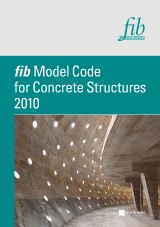Details

fib Model Code for Concrete Structures 2010
1. Aufl.
|
169,00 € |
|
| Verlag: | Ernst & Sohn |
| Format: | |
| Veröffentl.: | 01.10.2013 |
| ISBN/EAN: | 9783433604083 |
| Sprache: | englisch |
| Anzahl Seiten: | 434 |
DRM-geschütztes eBook, Sie benötigen z.B. Adobe Digital Editions und eine Adobe ID zum Lesen.
Beschreibungen
The International Federation for Structural Concrete (fib) is a pre-normative organization. 'Pre-normative' implies pioneering work in codification. This work has now been realized with the fib Model Code 2010. The objectives of the fib Model Code 2010 are to serve as a basis for future codes for concrete structures, and present new developments with regard to concrete structures, structural materials and new ideas in order to achieve optimum behaviour.<br> The fib Model Code 2010 is now the most comprehensive code on concrete structures, including their complete life cycle: conceptual design, dimensioning, construction, conservation and dismantlement. It is expected to become an important document for both national and international code committees, practitioners and researchers.<br> <br> The fib Model Code 2010 was produced during the last ten years through an exceptional effort by Joost Walraven (Convener; Delft University of Technology, The Netherlands), Agnieszka Bigaj-van Vliet (Technical Secretary; TNO Built Environment and Geosciences, The Netherlands) as well as experts out of 44 countries from five continents.
1 SCOPE<br> - Aim of the Model Code<br> - Format<br> - Levels of approximation<br> - Structure of the Model Code2<br> 2 TERMINOLOGY<br> - Definitions<br> - References<br> 3 BASIC PRINCIPLES<br> - General<br> - Performance-based design and assessment<br> - Performance requirements for serviceability, structural safety, service life and reliability<br> - Performance requirements for sustainability<br> - Life Cycle Management<br> 4 PRINCIPLES OF STRUCTURAL DESIGN<br> - Design situations<br> - Design strategies<br> - Design methods<br> - Probabilistic safety format<br> - Partial factor format<br> - Global resistance format<br> - Deemed-to-satisfy approach<br> - Design by avoidance<br> 5 MATERIALS<br> - Concrete<br> - Reinforcing steel<br> - Prestressing steel<br> - Prestressing systems<br> - Non-metallic reinforcement<br> - Fibres/Fibre Reinforced Concrete<br> 6 INTERFACE CHARACTERISTICS<br> - Bond of embedded steel reinforcement<br> - Bond of non-metallic reinforcement<br> - Concrete to concrete<br> - Concrete to steel<br> 7 DESIGN<br> - Conceptual design<br> - Structural analysis and dimensioning<br> - Verification of structural safety (ULS) for predominantly static loading<br> - Verification of structural safety (ULS) for non-static loading<br> - Verification of structural safety (ULS) for extreme thermal conditions<br> - Verification of serviceability (SLS) of RC and PC structures<br> - Verification of safety and serviceability of FRC structures<br> - Verification of limit states associated with durability<br> - Verification of robustness<br> - Verification of sustainability<br> - Verifications assisted by numerical simulations<br> - Verification assisted by testing<br> - Detailing<br> - Verification of anchorages in concrete<br> 8 CONSTRUCTION<br> - General<br> -Execution management<br> - Reinforcing steel works<br> - Prestressing works<br> - Falsework and formwork<br> - Concreting<br> 9 CONSERVATION<br> - General<br> - Conservation strategies and tactics<br> - Conservation management<br> - Condition survey<br> - Condition assessment<br> - Condition evaluation and decision-making<br> - Interventions<br> - Recording<br> 10 DISMANTLEMENT<br> - General<br> - Preparing dismantlement<br> - Safety and health provisions<br>
The fib Model Code 2010 was produced during the last ten years through an exceptional effort by Joost Walraven (Convener; Delft University of Technology, The Netherlands), Agnieszka Bigaj-van Vliet (Technical Secretary; TNO Built Environment and Geosciences, The Netherlands) as well as experts out of 44 countries from five continents.
<p>Structural concrete is more than a continuously developing material. It also represents a remarkable development in design concepts and strategies. Requirements for concrete structures have often been formulated as follows: concrete structures should be safe, serviceable, durable, economic and aesthetic. Today, several further requirements or expectations regarding concrete structures have to be met, for example: they should be robust enough to avoid progressive collapse, should need only minimal maintenance during their specified service life, should allow the use of high performance materials, should<br /> provide protection against accidents, should provide barriers against or following hazards, should be designed with due attention to dismantlement, should support sustainability in all possible ways, and in addition, provide adequate fire and earthquake resistance and be environmentally compatible.</p> <p>The objectives of the fib Model Code for Concrete Structures 2010 are (a) to serve as a basis for future codes for concrete structures, and (b) to present new developments with regard to concrete structures, structural materials and new ideas in order to achieve optimum behaviour. The fib Model Code for Concrete Structures 2010 includes the whole life cycle of a concrete structure, from design and construction to conservation (assessment, maintenance, strengthening) and dismantlement, in one code for buildings, bridges and other civil engineering structures. Design is largely based on performance requirements. The chapter on materials is particularly extended with new types of concrete and reinforcement (such as fibres and non-metallic reinforcements).</p> <p>The fib Model Code for Concrete Structures 2010 – like the previous Model Codes − not only specifies requirements but also gives corresponding explanations in a separate column of the document.</p> <p>The fib Model Code for Concrete Structures 2010 is now the most comprehensive code on concrete structures, including their complete life cycle: conceptual design, dimensioning, construction, conservation and dismantlement. It is expected to become an important document for both national and international code committees, practitioners and researchers.</p> <p>The fib Model Code for Concrete Structures 2010 was produced during the last ten years through an exceptional effort by Joost Walraven (Convener; Delft University of Technology, The Netherlands), Agnieszka Bigaj-van Vliet (Technical Secretary; TNO Built Environment and Geosciences, The Netherlands) as well as experts from 44 countries in five continents.</p>
Diese Produkte könnten Sie auch interessieren:

Composite Structures according to Eurocode 4

von: Darko Dujmovic, Boris Androic, Ivan Lukacevic

97,99 €

Eurocode 2 für Deutschland. Kommentierte Fassung

von: Deutscher Beton- und Bautechnik-Verein e.V.

104,99 €














